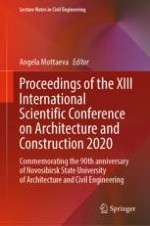2021 | OriginalPaper | Chapter
Energy-Efficient Renewable Energy Techniques for Architectural Installations
Author : Natalia Saprykina
Published in: Proceedings of the XIII International Scientific Conference on Architecture and Construction 2020
Publisher: Springer Nature Singapore
Activate our intelligent search to find suitable subject content or patents.
Select sections of text to find matching patents with Artificial Intelligence. powered by
Select sections of text to find additional relevant content using AI-assisted search. powered by
